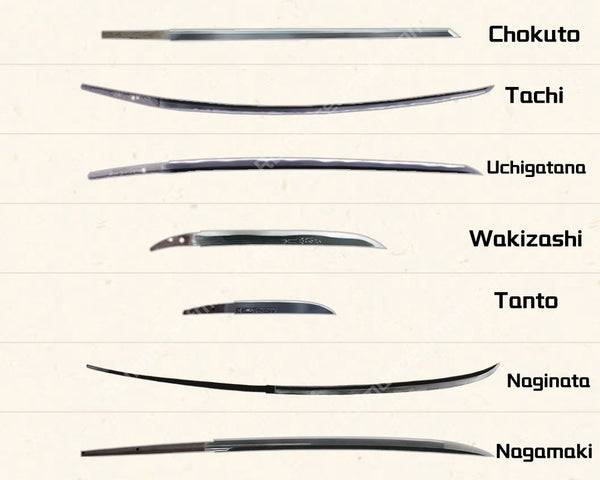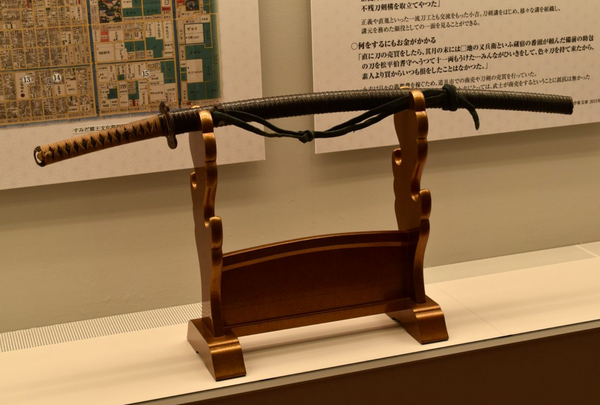What is Uchigatana? Introduction of this Sharp and Sleek Samurai Sword
What is Uchigatana
Uchigatana is the Katana we all familiar with, literally translated to "Striking sword" 打刀. We talk about Katana all the time, but the meaning of "Katana" is slightly different in English and Japanese. We will explain to you in details:
Katana, means "Single edged blade" in Japanese, and it refers to all types of Japanese swords.

Katana in English, according Oxford Dictionaries, means "a long, single-edged sword used by Japanese samurai.". While this is basically correct, it's vague. A samurai could use Tachi, Uchigatana, Naginata, or even Yari (spear), and they all means "Katana" in Japanese.
Since Uchigatana is the most iconic and recognizable type of Katana, in English, most cases people are referring to Uchigatana when they use Katana. Many people often get confused about the different types of Katana, leading to common mistakes like calling a Tachi (太刀) or Wakizashi (脇差) a Katana. This confusion also causes some to incorrectly criticize those who wear a Katana with the edge facing downward, not realizing that it's actually a Tachi.

Knowing Uchigatana is the formal Japanese term for Katana, you already have more knowledge about these swords than many others. You will have the answer when you were asked "What is the difference between Uchigatana and Katana", Uchigatana and Katana in English, basically means the same thing. Anyone try to name some difference, is showing their lack of knowledge of Japanese swords.
Table of Content
Features of Uchigatana
"Uchigatana" became widely popular among samurais from the middle of the Muromachi period. It is characterized by a blade length of 2 shaku (about 24 inches or 60 cm) or more, with a slight curve (Sori) in the body of the blade.
Difference between Uchigatana and Tachi
Many people will confuse Tachi for Uchigatana. It's true that they share many things in common, the overall shape, the fittings etc. But they are not the same, and here are the two major difference you can check to distinguish Tachi and Uchigatana.
1) Blade Shape The length for Uchigatana and Tachi are very similar (both more than 24 inches / 60cm). The most identical difference is their curve (Sori). Tachi is more curve than Uchigatana, it's more like a saber in some point.
2) How They're Worn: Tachi swords are usually worn hanging from the belt with the edge facing down, while Uchigatana are typically worn with the edge facing up. Also when uchigatana is displayed, it is placed with the blade facing upwards, the same direction as when worn at the waist.
Remember the major difference, is from their usage. Tachi were often used by cavalry. Their design is ideal for downward strikes from horseback. Uchigatana, on the other hand, became popular among foot soldiers for their ease of drawing and versatility.
How long is Uchigatana

There are not strict requirements. But usually Uchigatana has an overall length of approximately 100 cms (or about 39 inches), with the blade itself measuring around 70 cms (roughly 27.5 inches) in length, the handle is about 30cm (11 inches).
This measurement refers to the entire length of the sword, the blade length is called "Nagasa". Depends on your height and the swordsmanship, Nagasa is something you might want to customize on your own katana.
History of Uchigatana

Kamakura Period (12th Century): The prototype of the Uchigatana (打刀) emerged as a type of short sword known as "Sasuga" (刺刀). It was primarily wielded by lower-ranking foot soldiers accompanying higher-ranking cavalry.
Nanboku-chō Period: During this era, as longer Ōdachi (大太刀) swords became popular, the Sasuga also evolved into longer blades.
Muromachi Period: This period saw the transformation of the Sasuga into the Uchigatana. Originally having a flat construction (similar to short swords), it later adopted the ridge-line construction like the Tachi (太刀).
Ōnin War and Beyond: The mainstream samurai sword shifted from the Tachi to the Uchigatana due to changes in battlefield tactics. This transition was marked by the move from horseback archery to infantry battles. Infantry troops were mainly equipped with spears and matchlock guns, leading to the decline of Naginata (薙刀) and the rise of the Uchigatana.
Azuchi-Momoyama to Edo Period: Following Toyotomi Hideyoshi's sword hunt and the establishment of the Tokugawa shogunate, the simultaneous carrying of Uchigatana and Wakizashi (脇差) became the official samurai attire, symbolizing their status. This period marked a shift from the bow and arrow (弓箭, Yumi) as the samurai symbol to a greater focus on swords and swordsmanship.

Late Edo Period: The Uchigatana saw extensive use in small-scale urban conflicts, especially during the tumultuous late Edo period.
Uchigatana Parts

Uchigatana has many parts that contribute to its function and beauty. We will explain each part and categorize them under three main sections: Blade, Saya (scabbard), and Tsuka (handle).
Blade
- Nakago: The tang of the sword, which is the part of the blade that extends into the handle.
- Nagasa: The length of the sword blade.
- Kissaki: The tip of the sword.
- Mune: The back of the blade, which is opposite the cutting edge.
- Habaki: A metal collar around the blade, right above the guard, to keep the sword secure in the scabbard.
- Hamon: The visual effect created on the blade by the hardening process.
- Boshi: The pattern of the hardened edge at the tip (Kissaki) of the blade.
- Yokote: The line that defines the start of the Kissaki.
- Hasaki: The cutting edge of the sword.
- Ha: Another term for the cutting edge.
- Monouchi: The part of the blade that's most effective for cutting, usually near the tip.
- Sori: The curvature of the blade.
Saya (Scabbard)
- Saya: The scabbard or sheath of the sword.
- Kurigata: A knob on the scabbard for attaching the Sageo.
- Kojiri: The end cap or tip of the scabbard.
- Koiguchi: The mouth of the scabbard, where the blade enters.
- Shitodome: An accent or fitting in the hole of the Kurigata.
Tsuka (Handle)
- Tsuka: The handle of the sword.
- Samegawa: Ray or shark skin covering the Tsuka.
- Mekugi: Small pegs made of bamboo that secure the blade in the Tsuka.
- Tsukaito: The wrapping or braid used on the Tsuka for grip.
- Kashira: The pommel or cap at the end of the Tsuka.
- Tsuba: The guard at the beginning of the Tsuka, between the handle and the blade.
- Sageo: The cord used to tie the Saya to the belt.
- Menuki: Decorative ornaments under the Tsukaito.
- Fuchi: The collar or sleeve at the end of the Tsuka, near the Tsuba.
- Seppa: Spacers around the Tsuba to ensure a tight fit.





















